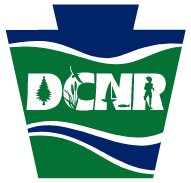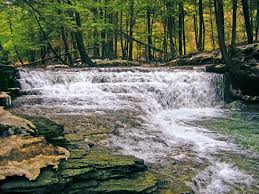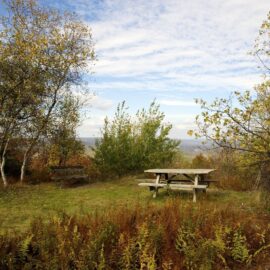Disclosure: I may earn affiliate revenue or commissions if you purchase products from links on my website. The prospect of compensation does not influence what I write about or how my posts are structured. The vast majority of articles on my website do not contain any affiliate links.
As the leaves turn and my time living with my parents in Scranton comes to a close, I’ve decided to reflect on what was a wonderful summer. I’ve visited a large number of Pennsylvania State Parks since I left Chicago. My perspective has been unique in that I’ve run on the trails, whereas most people are hiking or walking their dogs or other things. With a great summer behind me, I’m ready to post a power ranking of the PA parks from a runner’s perspective.
13. Archbald Pothole State Park
This is a tiny park with a small trail system that can be walked in a matter of 10 minutes. With some bushwacking, you can make it over to Ed Staback Park to the east, but the trail system there is more for dog walking than serious running. You can skip this park.
12. Francis Slocum State Park
A large park with a horseshoe lake, Francis Slocum fails in that there’s no continuity in the trails to run. You can’t lap the circumference of the lake, which is a huge negative. So you’re stuck on smaller trail or road loops or simple out-and-backs.
The trail around what should be the most prominent part of the lakeshore peninsula trail is extremely grown-in and hard to navigate. There are also minor paved portions that must be traveled as you move counter-clockwise around the lake.
The focal point of the park, for me, was the Larch Tree Trail. It’s a shorter trail that takes you through a fairytale-esque grove of amber larch trees. These trees are surrounded by a new growth of a neon-looking type of long grass. The colors were extremely vivid. The scene was completely unprecedented for late-summer Pennsylvania.
11. Varden Conservation Area
This is a pretty small park with a decent trail system. It shines because it’s the home cross country course for Western Wayne High School, which is located adjacent to the park. This means that some segments of trail are immaculately maintained. The segment here that cuts straight through the field is prime for cross country hill work. However, I found that the wooded trails had turns that were very tight.
Generally, most will place Francis Slocum ahead of this one.
10. Big Pocono State Park
This park begins at the top of Camelback Ski Resort in the Poconos. It’s a unique setting for a park and has several impressive vistas but due to its location, you can expect a large amount of NY/NJ trail traffic around the trailheads.
This is low on the list because there’s only one dimension to it. As a runner, you should run down the south trail then run up the north trail. There’s no easy, low-heartrate way to do this. The final ascent is a huge effort.
The Indian Trail, leading to a stunning vista, is impossible to run on due to being entirely composed of jagged rocks.
The trail that cuts across the mountain with no elevation changes is beautiful, though it’s at the farthest point from the park’s trailheads. This passes through a natural rock canyon with mature mountain laurel, very rewarding but, again, one-dimensional.
9. Promised Land State Park
This is a large park flanked by the Bruce Lake Nature Area and Delaware State Forest. As a whole, I’m sure some people would consider it a top-5 NEPA park, but my experience running it was pretty mediocre.
The only trail around Promised Land Lake is the Boundary Trail, which was not particularly enjoyable. Tons of spider webs and technical terrain without any major views or anything of note. I missed two pretty important turns which meant I was stuck on the road for a mile or two.
The conservation island was cool and some segments deep on the boundary trail were exciting. Honestly, my favorite part was a trail that was located in the Delaware State Forest.
8. Prompton State Park
Prompton is the ultimate wildcard. Huge lake, large trail network, but maintained by volunteers. Mid-summer: not so great. Late winter: probably ideal.
I admit we lost the trail a few times. On the west side of the lake, the trail is just a single-track mountain biking trail. On the other side, there’s more variety and climbs, along with some really cool interior views. There’s really no point in running here unless you’re going to lap the lake, which sets you up for something like a nine-mile commitment. You will probably be all alone for the majority of your excursion.
7. Mt. Pisgah State Park
Compared to Lackawanna State Park, Mt. Pisgah State Park’s trails are wide and very easy to run on. They’re free of most of the hazards that I’ve come to expect at Lackawanna State Park.
Unfortunately, the park is a bit smaller than others in this class. But it’s unique in that the focal point isn’t Stephen Foster Lake, it’s Mount Pisgah. This park gets a middle ranking because the trail to climb Mt. Pisgah is pretty much the most extreme yet runnable grade you’re going to find in PA. All the other trails–without exception–are a ton of fun to run on.
Loses some points because it’s so far away from everything.
6. Lackawanna State Park
This is the hometown classic. I’m biased because I’ve run well over one hundred miles here, but also because I still haven’t run all of the trails. My complaint is that it tends to be technical with very few opportunities to zone out and crack some fast miles.
I’ve still never run North Woods or South Branch.
5. Tobyhanna State Park
5-mile mostly-shaded mostly-dirt trail surrounding a body of water. With gradual downhills. At altitude. This is one park that punches above its weight class. A few other trails, including one that connects to Gouldsborough State Park, for those looking to adventure. The main track is all business.
4. Rickett’s Glen State Park
Now we’re in rarified territory. To make the top 4 on this list, the park had to have provided a memorable experience. The glens at Rickett’s Glen are magnificent, but also incredibly hard to run around. If you stay on other trails, you’ve got a great trail system that makes it really easy to add on additional loops. The only knock is that the trails are nondescript compared to the parks ahead of it on this list.
Make no mistake–in terms of a “things to see” park, Rickett’s Glen is probably number one in all of Pennsylvania.
3. Salt Springs State Park
Salt Springs has some wild climbs and nearly unparalleled terrain diversity for its size. There are a lot of “back mountain” trails maintained by a volunteer group that make the trail network really special.
Taking the Upland Trail to the Friends Trail system was extremely rewarding. This was one of my best runs of the summer. The only negative here is that trail entry from the main day-use area is confusing, and there’s nothing particularly unique aside from the deep-woods Frog Pond or short Hemlock Trail.
You will find many of the trails to be extremely desolate and the markings aren’t the best.
2. Hickory Run State Park
This state park is massive to the point that trying to run a loop from a main parking area to the boulder field and back will be exhausting. I thought I had made wrong turns but I hadn’t. My total run was about 17 miles and I was exhausted.
A lot of the trails here were really tight single-tracks with spiderwebs galore. But, as a whole, this is a really versatile state park. The Fourth Run Trail, at 4.8 miles, was by far the trail of the summer for me.
1. Worlds End State Park
Worlds End takes the compact-yet-diverse trail system of Salt Springs and adds in a large river, waterfalls (in season), beautiful mountain vistas, and impressive geological formations. If you’re game for an 11-mile run with a few cliff scrambles, this is the best I’ve found so far in Pennsylvania.
There are few spiderwebs or wildlife concerns since almost all of the trails are relatively close to trailheads and are well-traveled daily. If you get there late, or, like me, take ninety minutes to get there and spend two hours running around, you’re going to run into trail traffic.
The Loyalsock Trail (system) cuts through the park and provides some of the best terrain you will find. The trails on the north end of the creek are quite intense, while those on the south end are more well-traveled and hiker-friendly.
What About … ?
I highly doubt that I will visit the remaining 100+ state parks in any significant numbers. Between driving and running time, some of these visits turned into 5 or 6 hour affairs. My opinion is that NEPA, between the Endless Mountains, Pocono Mountains, and whatever other mountains, probably has the greatest terrain/habitat diversity, and thus the most impressive lineup of state parks.
I’ve looked into the majority of remaining parks, and a large number would be precluded from consideration simply by being too small. Sure, some of them will be embedded in a larger state forest or regional park’s trail system, which is excluded from the acreage. I’m just not a completionist to the point that I want to drive four hours to run a 5-mile loop.
Parks I consider too small: Sand Bridge, Prouty Place, Upper Pine Bottom, Hyner View, Laurel Summit, McCalls Dam, Patterson, Buchanan’s Birthplace, Susquehanna, Poe Paddy, Mont Alto, Point, Penn-Roosevelt, Allegheny Islands, Big Spring, Ralph Stover, Cherry Springs, Ravensburg, Milton, Samuel S. Lewis, Bendigo, Fowlers Hollow… you get the picture.
A surprising amount in the “medium size” tier don’t have great trail systems, similar to Francis Slocum. I won’t name them because I don’t think it’s fair to pass judgement.
In any case, NEPA has some excellent places to run and I hope this post can inform some of your own adventures!




